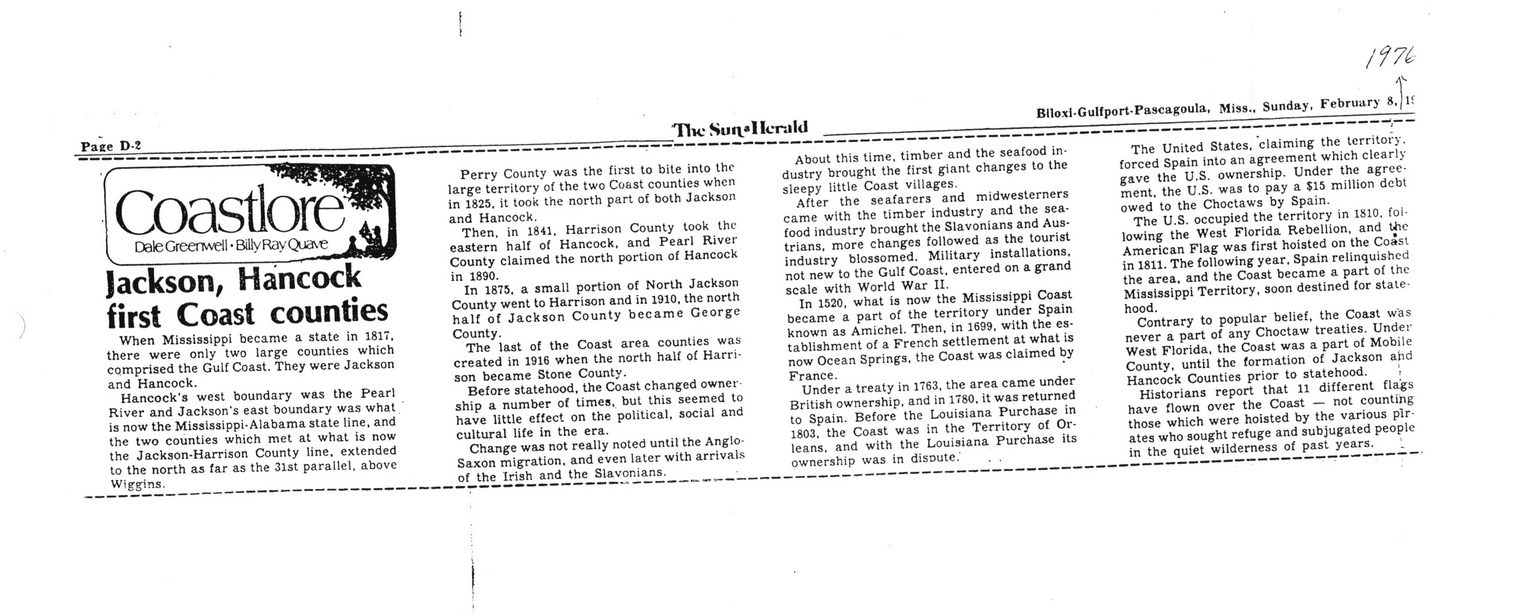This text was obtained via automated optical character recognition.
It has not been edited and may therefore contain several errors.
Page D ! Tlic Sun.*! Icrald Blloxl-Gulfport-Pascagoula, Miss., Sunday, February 8,|lf (---------------nBTn Coastloref^ Dale Greenweil • Billy Ftey QuaveJ^jfti Jackson, Hancock first Coast counties When Mississippi became a state in 1817, there were only two large counties which comprised the Gulf Coast. They were Jackson and Hancock. Hancock’s west boundary was the Pearl River and Jackson's east boundary was what is now the Mississippi-Alabama state line, and the two counties which met at what is now the Jackson-Harrison County line, extended to the north as far as the 31st parallel, above Wiggins. Perry County was the first to bite into the large territory of the two Coast counties when in 1825, it took the north part of both Jackson and Hancock. Then, in 1841, Harrison County took the eastern half of Hancock, and Pearl River County claimed the north portion of Hancock in 1890. In 1875, a small portion of North Jackson County went to Harrison and in 1910, the north half of Jackson County became George County. The last of the Coast area counties was created in 1916 when the north half of Harrison became Stone County. Before statehood, the Coast changed owner ship a number of times, but this seemed to have little effect on the political, social and cultural life in the era. Change was not really noted until the Anglo-Saxon migration, and even later with arrivals of the Irish and the Slavonians. About this time, timber and the seafood industry brought the first giant changes to the sleepy little Coast villages. After the seafarers and midwesterners came with the timber industry and the seafood industry brought the Slavonians and Aus-trians, more changes followed as the tourist industry blossomed. Military installations, not new to the Gulf Coast, entered on a grand scale with World War II. In 1520, what is now the Mississippi Coast became a part of the territory under Spain known as Amichel. Then, in 1699, with the establishment of a French settlement at what is now Ocean Springs, the Coast was claimed by France. Under a treaty in 1763, the area came under British ownership, and in 1780, it was returned to Spain. Before the Louisiana Purchase in 1803, the Coast was in the Territory of Orleans, and with the Louisiana Purchase its ownership was in dispute.' . . The United States, claiming the territory, forced Spain into an agreement which clearly gave the U.S. ownership. Under the agreement, the U.S. was to pay a $15 million debt owed to the Choctaws by Spain. The U.S. occupied the territory in 1810, following the West Florida Rebellion, and the American Flag was first hoisted on the Coast in 1811. The following year. Spain relinquished the area, and the Coast became a part of the Mississippi Territory, soon destined for statehood. Contrary to popular belief, the Coast was never a part of any Choctaw treaties. Under West Florida, the Coast was a part of Mobile County, until the formation of Jackson and Hancock Counties prior to statehood. Historians report that 11 different flags have flown over the Coast — not counting those which were hoisted by the various pirates who sought refuge and subjugated people in the quiet wilderness of past years. L

Hancock County Newspaper-clipping-1976